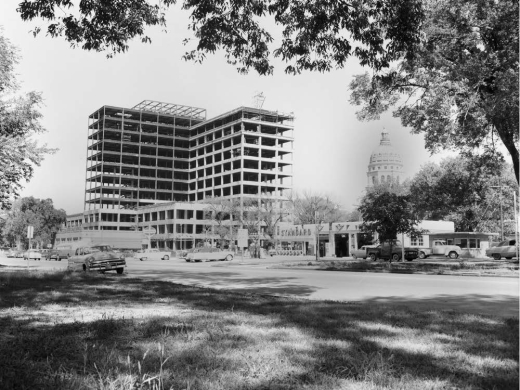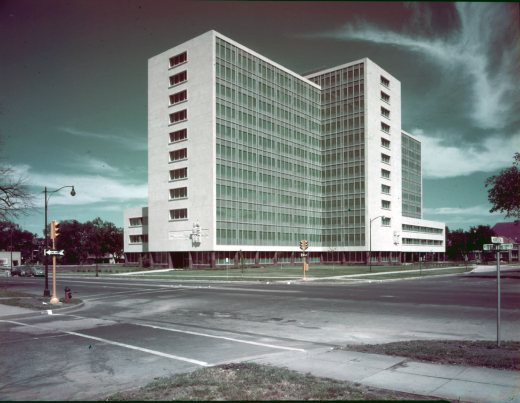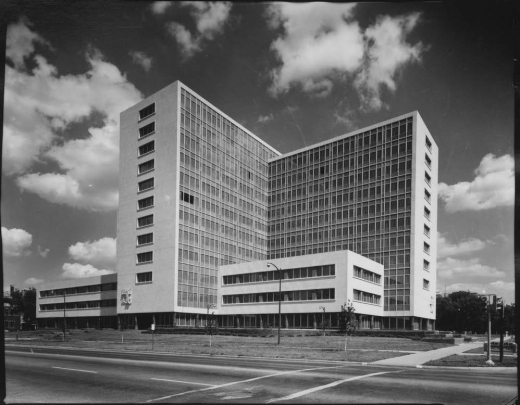Motivated by the proposed demolition of the Docking State Office Building, in Topeka, Kansas, preservation advocates have organized to preserve the state’s rich modern architectural resources. A modernist gem neighboring the Kansas State Capitol, the 1957 Docking Building has been threatened with partial or complete demolition for over a decade. The dynamic, twelve-story building, which is listed on both the National and State Historic Registers, was designed by State Architect John A. Brown and was notable for its innovative double-glazed Thermopane curtain walls and integration of sculptural relief panels by Kansas artist Bernard “Poco” Frazier.(1) Originally named the Kansas State Office Building, the structure was one of the first modernist public buildings in the state and was built to endure for a century. The publicly funded building housed various state agencies until 2011 when then-Governor Sam Brownback removed more than 1000 employees with an intention to summarily raze the structure. This was ostensibly part of a broader privatization agenda that stood to benefit non-governmental landlords.
Threatened: The Docking State Office Building
Author
Michael Grogan
Affiliation
Plains Modern, Inc. and Kansas State University
Tags
However, as the basement housed the power plant for the capitol complex, demolition was narrowly avoided, launching a ten-year saga in which various proposals surfaced, most threatening the integrity of this notable work of architecture. Immediately following the Governor’s actions, the Kansas Preservation Alliance nominated the Docking for the National Register of Historic Places. After the Kansas Historic Sites Board of Review failed to take action for nearly six years, private citizens appealed to the National Park Service, which swiftly granted a National Register listing and, as a result, subjected proposed modifications to review under the state preservation statute.
Despite these statutory protections, plans for the building’s demolition continued. Current Governor Laura Kelly supported a proposal approved by State Finance Council in December 2021.(2) The plan, first floated by State Senator J.R. Claeys in an October 2021 Legislature’s Joint Committee on State Building Construction, called for the demolition of the upper nine stories, while maintaining the first three floors for meeting and event space.(3) After the State Historic Preservation Officer determined in their state law review that the proposed project would “encroach upon, damage, or destroy” the historic property, the Governor overruled the decision, determining that there were “no feasible and prudent alternatives” to the project. Although the project would utilize $60 million in federal economic stimulus dollars the Advisory Council on Historic Preservation has determined that state-sponsored ARPA-funded projects are exempt from review under the National Historic Preservation Act (36 CFR Part 800).
Furthermore, there is confusion as to what plan the Department of Administration is currently executing. Whereas the State Finance Council in December agreed to renovate the Docking to encompass three floors of office and meeting space, a recent “Notice of Commencement of Negotiations for Design-Build Services” by the Kansas Department of Administration calls for “selectively dismantling the 1st through 14th floors above-grade,” thus, effectively the whole Docking Building except the basement power plant.(4) This references a $120 million estimated budget with a scope that represents a significant discrepancy from that officially approved by the State Finance Council. Additionally, the estimated costs for either version must be questioned since neither proposal appears to have been externally vetted.
Despite the Governor’s findings that there are “no feasible…alternatives,” this current plan—whichever that may be—was hastily proposed without any serious study, and a number of other options, including full renovation, had been analyzed in a thorough 2020 report by the Kansas City architectural firm Clark Huesemann, LC.(5) In fact, two of the study’s options were the basis of the October 11th meeting, but both schemes were inexplicably supplanted by Claey’s proposal.
Just over a year ago $129 million was earmarked for full renovation of the Docking, potentially covering the then-estimated $127.3 million cost.(6) However, the plan for full renovation was quickly challenged by downtown Topeka property owners concerned that the renovation of the building’s 424,600 square feet will affect the private office market, already affected by the pandemic.
Nonetheless, the actual impact of returning certain government agencies to the Docking has not been evaluated. As recently as 2018 it was optimistically reported that downtown Topeka office lease rates had been on the rise due to increased demand, with the forecast, “We’re probably seeing a good 10 to 20 percent increase over two or three years.”(7) Also, plans produced by the City of Topeka and Downtown Topeka, Inc. show a strong demand for downtown housing.
Destroying a landmark building based on unfounded fears is a shortsighted response. More logical is to have a conversation about how reusing this newly designated icon may benefit the local neighborhood as well as the residents of Kansas at large. Consolidating offices in government owned spaces will cost less to the citizens than renting scattered spaces throughout downtown and this listing creates new opportunities such as a mixed-use program that may begin to address both the need for downtown housing and spur economic vitality west of the capitol. None of the discussions have yet engaged the community west of the capitol, for instance.
Based on the facts of this complicated story, and acknowledging that the current proposal will “irreparably damage” this “Kansas icon,” the modernist advocacy group Plains Modern, Inc. has petitioned for judicial review of the decision-making process. As the group articulated in a May 13th media statement, they are challenging the Governor’s “failure to consider prudent and feasible alternatives to destroying the integrity of Docking, a nationally registered historic building” requesting "any pending demolition be ceased and that the Governor desist from demolishing the Docking Building."(8) They point out that, because the Finance Council decision predated the national listing, “options leveraging the special status, such as tax credits, were not considered.” Finally, they state, “Allowing the project to proceed in spite of leadership’s blatant disregard for preservation statute sets disturbing precedent, denies future generations a chance to learn from this historical building, and potentially endangers Kansans’ access to federal tax credits to maintain other privately owned, income-producing historic properties.”
This effort extends beyond protecting the Docking. Plains Modern, Inc. and the preservation community believed there were strong preservation laws in Kansas, but this review process has revealed that, for state-owned properties, the statute dictates no way for the public to be informed of SPHO's decision making on the appropriateness of a project per the Secretary of Interior's standards. Nor are the governing bodies (in this case, the Governor) required to publish their final orders. If state leaders can use these oversights in the statute to quietly circumvent the preservation law, then all state-owned buildings are threatened regardless of their listing status. This is an acute problem for modernism since so many large post-war projects are state buildings. Unfortunately, leadership actions in this case contradict the letter and spirit of Kansas preservation statute, which states that “preservation should be among the highest priorities of government.”
Plains Modern and the Kansas preservation community hope that the courts will give this petition serious consideration and that the state government, local real estate interests, and Topekans will work together to explore feasible alternatives for addressing the community’s real estate needs without destroying more than 400,000 square feet of iconic Modern architecture.
Notes
-
For more description of the Docking Building’s architectural merits see David Griffin, “Docking State Office Building,” Kansas Preservation 33, no.1 (2011): 5-7, accessed June 5, 2022, https://www.kshs.org/resource/ks_preservation/2011v33n1.pdf.
-
Tim Carpenter, “Kansas preservation group raises objections to Docking building reconfiguration,” Kansas Reflector, May 19, 2022, accessed June 5, 2022, https://kansasreflector.com/2022/05/19/kansas-preservation-group-raises-objections-to-docking-building-reconfiguration/.
-
Noah Taborda, “Kansas Legislators Recommend Turning Docking State Office Building Into Three-Story Event Center,” Kansas Reflector, October 12, 2021, accessed June 5, 2022, https://kansasreflector.com/2021/10/12/kansas-legislators-recommend-turning-docking-state-office-building-into-three-story-event-center/.
-
State of Kansas Department of Administration—Office of Facilities and Property Management, “Notice of Commencement of Negotiations for Design-Build Services,” Kansas Register 41, no. 14 (April 7, 2022), accessed June 14, 2022, https://www.sos.ks.gov/publications/register/volume-41/issues/issue-14/04-07-22-49998.html.
-
Clark Huesemann LC, “Docking State Office Building,” (Building Study, January 10, 2020), accessed June 5, 2022 https://admin.ks.gov/docs/default-source/offce-of-public-affairs/docking-1-21-2020.pdf.
-
Kansas Legislative Research Department, “Committee Reports to the 2022 Kansas Legislature,” March 2022, 7-15, accessed June 6, 2022, Committee Reports to the 2022 Kansas Legislature Supplement, March 2022 (kslegresearch.org).
-
Morgan Chilson, “Downtown Revitalization Affecting Office Lease Rates,” The Topeka Capitol-Journal, June 26, 2018, accessed June 5, 2022, https://www.cjonline.com/news/20180616/downtowns-popularity-slowly-increasing-office-lease-rates.
-
Plains Modern, Inc., “Media Statement” may be downloaded through their Facebook.com organization page, https://www.facebook.com/groups/1873173472874561/permalink/1874703612721547/.
About the Author
Michael Grogan is a founding member and Director of Plains Modern, Inc. and an Assistant Professor of Architecture at Kansas State University. He was also the 2021 American Institute of Architects Kansas President. His research interests are focused on adaptations to and preservations issues with U.S. postwar architecture. His essay on Mies van der Rohe’s two additions to the Museum of Fine Arts, Houston was recently published in Arris 31, the annual journal of the Southeast Chapter of the Society of Architectural Historians and he authored “Plains Modern: Postwar Architecture in Kansas,” published December 2020 as part of the Docomomo US Regional Spotlight on Modernism series as well as a Docomomo US Travel and Leisure article, “Spa City Modernism: Postwar Hotels in Hot Springs, Arkansas” in August 2021.
Other contributors to this article are Colene J. Lind and Christy Davis.




